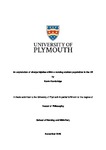An exploration of sharps injuries within a nursing student population in the UK
| dc.contributor.supervisor | Endacott, Ruth | |
| dc.contributor.author | Hambridge, Kevin | |
| dc.contributor.other | Faculty of Health | en_US |
| dc.date.accessioned | 2019-11-21T15:10:10Z | |
| dc.date.available | 2019-11-21T15:10:10Z | |
| dc.date.issued | 2019 | |
| dc.identifier | 933059 | en_US |
| dc.identifier.uri | http://hdl.handle.net/10026.1/15173 | |
| dc.description.abstract |
Percutaneous injuries, such as sharps injuries, can transmit up to 60 different types of pathogen (Tarantola et al., 2006) to the injured party. Whilst up to 100% of some nursing student populations sustain sharps injuries (Trivedi et al., 2013), a dearth of research studies investigating the topic worldwide exist. It is unknown within the UK the devices contributing to sharps injuries, the incidence rates and the locations where they occur. The aims of this study were to identify the characteristics of sharps injuries within a nursing student population within the UK; to explore the experience of sharps injuries, concentrating on the potential psychological effects and to examine factors that influence nursing student behaviour in relation to sharps usage. Following a systematic review, a multi-phase mixed methods design was used. In Phase One a two-site survey was conducted with nursing students (n=1015) to explore the incidence and impact of sharps injuries. For Phase Two a Twitter Chat was orchestrated to investigate the experiences and effects of sharps injuries with nursing students and Registered Nurses (n=71). Phase Three comprised an audit of sharps injuries sustained in Clinical Skills Simulation Wards (n=3). For Phase Four, interviews were conducted with nursing students who had sustained a sharps injury (n=12) to discover their experiences and the impact of the injury. Findings were synthesised and examined in the context of Learning Theory. Findings showed that sharps injuries were most likely to occur with glass ampoules (34.9%), when students were preparing injections (65%) and in the second year of the programme (44.54%). Many contributing factors of the sharps injury were identified, with inexperience being the primary cause. Some nursing students reported various psychological impacts after sustaining the SI, which affected both professional and personal life. The qualitative findings were synthesised into 8 themes. The study identified that there were many factors which influence nursing student sharps usage behaviour, both in the educational institution and when in clinical placement. The thesis concluded that sharps injuries are common within nursing students, and can have many psychological impacts on the individual. Many factors were identified which influence student nurse behaviour in relation to how they learn about sharps usage. These factors have been amalgamated into a theoretical framework model, which may be useful to guide future education, practice and research. | en_US |
| dc.language.iso | en | |
| dc.publisher | University of Plymouth | |
| dc.rights | CC0 1.0 Universal | * |
| dc.rights.uri | http://creativecommons.org/publicdomain/zero/1.0/ | * |
| dc.subject | Nursing student | |
| dc.subject | Sharps injuries | en_US |
| dc.subject.classification | PhD | en_US |
| dc.title | An exploration of sharps injuries within a nursing student population in the UK | en_US |
| dc.type | Thesis | |
| plymouth.version | publishable | en_US |
| dc.identifier.doi | http://dx.doi.org/10.24382/481 | |
| dc.rights.embargoperiod | No embargo | en_US |
| dc.type.qualification | Doctorate | en_US |
| rioxxterms.version | NA |
Files in this item
This item appears in the following Collection(s)
-
01 Research Theses Main Collection
Research Theses Main



